
London Road Fire Station is a former fire station in Manchester, England. It was opened in 1906, on a site bounded by London Road, Whitworth Street, Minshull Street South and Fairfield Street. Designed in the Edwardian Baroque style by Woodhouse, Willoughby and Langham in red brick and terracotta, it cost £142,000 to build and was built by J. Gerrard and Sons of Swinton. It has been a Grade II* listed building since 1974.
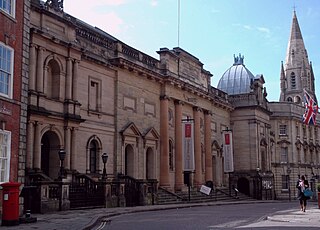
The National Justice Museum is an independent museum on High Pavement in the Lace Market area of Nottingham, England.

The Civic Centre is a municipal building located in the Cultural Quarter area within the city of Southampton, England. It comprises offices occupied by Southampton City Council, the SeaCity Museum, the Guildhall, the Southampton City Art Gallery, and the city library. It was designed by the English architect Ernest Berry Webber in the Classical style in 1929 and constructed over a ten-year period. It was completed in 1939. Pevsner's Hampshire: South describes it as "the most ambitious civic building erected in the provinces in the interwar years". It was designated as a Grade II* listed building in 1980.
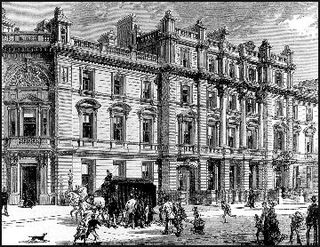
Bow Street Magistrates' Court became one of the most famous magistrates' court in England. Over its 266-year existence it occupied various buildings on Bow Street in Central London, immediately north-east of Covent Garden. It closed in 2006 and its work moved to a set of four magistrates' courts: Westminster, Camberwell Green, Highbury Corner and the City of Westminster Magistrates' Court. The senior magistrate at Bow Street until 2000 was the Chief Metropolitan Stipendiary Magistrate.

Stanford Hall is a grade II* listed 18th-century English country house in Nottinghamshire, England, in Stanford on Soar just north of Loughborough. It is home to the Defence and National Rehabilitation Centre (DNRC).
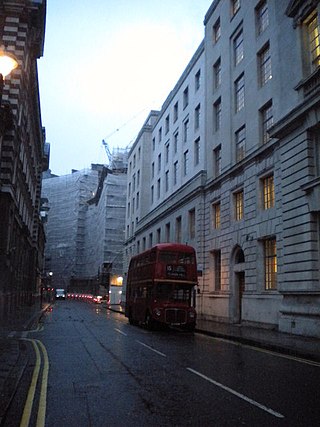
Great Scotland Yard is a street in Westminster, London, connecting Northumberland Avenue and Whitehall. By the 16th century, this 'yard', which was then a series of open courtyards within the Palace of Whitehall, was fronted by buildings used by diplomatic representatives of the Kingdom of Scotland. In the 19th century, it was a street and open space, which was the location of a public entrance to the original headquarters of the Metropolitan Police Service of London, causing the name "Scotland Yard" to become synonymous with the police service.

Nottingham Magistrates' Court is a magistrates' court in Nottingham, England.

High Pavement is a street in Nottingham in Nottinghamshire, England. It is one of the earliest streets in the city, and most of its buildings are listed.
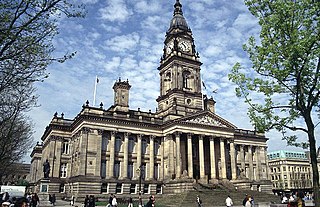
Bolton Town Hall in Victoria Square, Bolton, Greater Manchester, England, was built between 1866 and 1873 for the County Borough of Bolton to designs by William Hill of Leeds and George Woodhouse of Bolton. The town hall was extended in the 1930s to the designs of Bradshaw, Gass and Hope and has been designated a Grade II* listed building by English Heritage.
Frederick Hyde Pownall was a British architect. He was County Surveyor for Middlesex for about 45 years, and designed both Anglican and Roman Catholic churches.

Swyddfa'r Sir is a Grade II listed former hotel, former main offices of Ceredigion County Council and former Magistrates Court building located in Aberystwyth, well known as the outside of the police station in the BBC Wales police television series Y Gwyll (Hinterland).

Winton Square in Stoke-on-Trent, Staffordshire, England, houses Stoke-on-Trent railway station, the North Stafford Hotel, and several other historic structures. The square was built in 1848 for the North Staffordshire Railway, whose headquarters were in the station building, and is a significant example of neo-Jacobean architecture. Today, all the buildings and structures in the square are listed buildings and the square is a designated conservation area.
Thomas Charles Sorby was an English-Canadian architect. Born in Wakefield, England, he emigrated to Canada in 1883, where he worked for much of the time in Vancouver and Victoria, British Columbia.

The Justice and Police Museum is a heritage-listed former water police station, offices and courthouse and now justice and police museum located at 4-8 Phillip Street on the corner of Albert Street, in the Sydney central business district in the City of Sydney local government area of New South Wales, Australia. It was designed by Edmund Blacket, Alexander Dawson and James Barnet and built from 1854 to 1886. It is also known as Police Station & Law Courts (former) and Traffic Court. The property is owned by the Department of Justice, a department of the Government of New South Wales. It was added to the New South Wales State Heritage Register on 2 April 1999.

Gloucester Guildhall is a former municipal building in Eastgate Street, Gloucester, which is now used as a arts and theatre venue. It is a Grade II listed building.
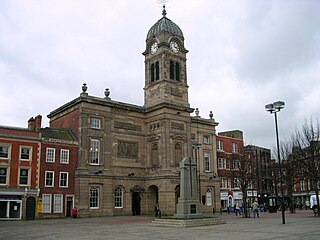
Derby Guildhall is a municipal building in the Market Place, Derby, England. It is a Grade II listed building.

The Former Police Station, Barton-upon-Humber is a Grade II Listed building in Barton-upon-Humber, North Lincolnshire, England.

The Dixon Hotel, in Tooley Street in the London borough of Southwark, is a former magistrates' court and police station designed by John Dixon Butler. Opened in 1906, it operated as a court until closure in 2013. Subsequently sold, it re-opened as The Dixon, in honour of the building's architect, and became a hotel operating as part of the Marriott International group. It is a Grade II listed building.

John Dixon Butler was a British architect and surveyor who had a long, professional association with London's Metropolitan Police. During his 25-year career with the police, he completed the designs and alterations to around 200 police buildings, including ten courts; as of 2022, about 58 of his buildings survive. Historic England describes him as "one of the most accomplished Metropolitan Police architects" and have included around 25 of his buildings on the National Historic List of England and Wales.

Tenby Town Hall is a municipal building in the High Street, Tenby, Pembrokeshire, Wales. The structure, which is used as an events venue, is a Grade II listed building.





















